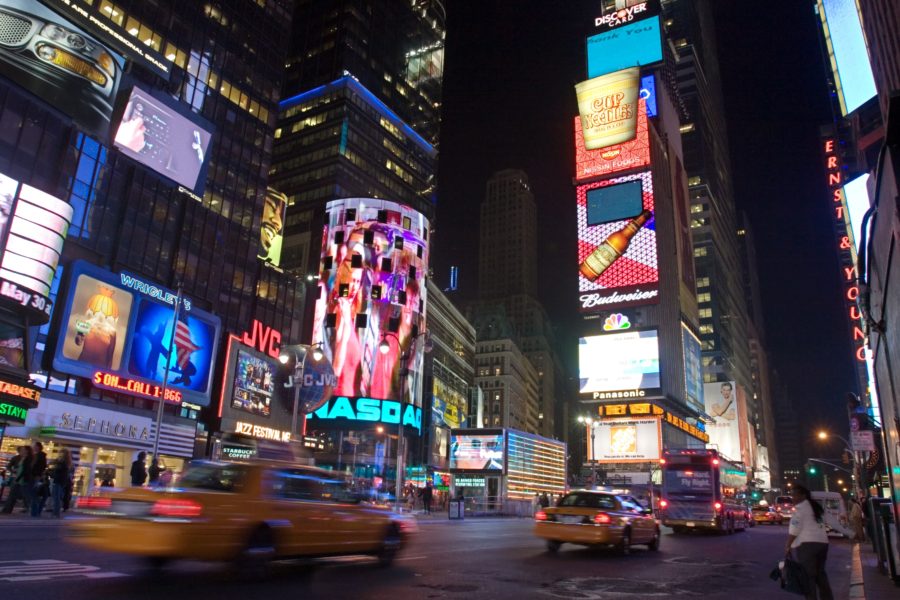
Synonymous with New York and a magnet for tourists, Times Square is the epicentre of the Big Apple experience for visitors to the city. Not just famed for the theatres and restaurants that fill the area, its dazzling display of larger than life advertisements have their own pull too.
For some it may be a surprise that Times Square was once an area of seediness and criminality before it was ‘Disneyfied’. The advertisements showing off their fancy products, sitting above the grime and dirt of the street, produced a bizarre juxtaposition. Fritz Lang took inspiration from Times Square at this time for his dystopian film Metropolis.
This mixture of tourism and history gives the Times Square’s advertisements significance, while if they were erected anywhere else today they’d likely be seen as an over-the-top eye sore. In New York, they’re an attraction.
For over 100 years—the first electric advertisement went up there in 1904—companies have attempted to take advantage of the ever-increasing foot traffic below the boards. If you’re interested, you can see here how these brands tussle to gain the attention of onlookers. Rather ironically, if you want to change cameras, you’ll have to watch an advert first.
One of the original big hitters of Times Square was the chewing gum manufacturer Wrigley. Their huge sign (likely the largest electric sign on the planet at the time) became an attraction among attractions. It stuck around for nearly seven years from 1917, while the company went on to create another one in 1936.
Then, in 2001, they were back again. The New York Times reported that the gum company would return to Times Square and replace their previous one they took down in 1960. As a nod to the reputation it built with its previous sign, Wrigley put up a teaser to advertise their return. This again highlighted the power of Times Square: people actually made an effort to see advertisements here. That’s a rare opportunity for advertisers, especially today.
The adverts themselves have changed a lot over time, but there have always been attempts to push the boundaries. A huge board of flashing neon lights is great, but anyone with enough money in the 1920s could do the same thing. When you compete in an area famous for its flashy advertisements, you need to stand out.
A classic example comes from Camel, whose advertisements in general are iconic. They set up their billboard with a novel feature: a hole that blew out smoke every four seconds (it was actually steam).
On top of the smoke, they placed their advertisement, always depicting someone enjoying a Camel cigarette. They did this for two and a half decades. You can see an example here and here and a video here.
This kind of innovative display is important at Times Square. People might be there for the adverts, but there’s a lot of movement. If you don’t grab someone’s attention, they’ll be long gone. A Forbes article has addressed this, saying that the Times Square audience “has an incredibly short attention span,” so stories and reveals don’t work.
Puffing out fake smoke might be a bit low tech, but it works. In the modern age, more advanced technology offers other solutions. New York City has taken broad steps to modernize and brands need to take advantage. Take Toyota, for example. To advertise their Prius they created an app that lets you add drawings to their Times Square advertisement itself. By offering direct interaction, grabbing someone’s focus can be a lot easier.
Meanwhile others are using new display technologies to create stunning spectacles to attract the eye. The below example advertises The Andy Warhol Museum. Not only does it look amazing, but it highlights the faith advertisers have in Times Square in the sense that people will see an advertisement there and travel to a museum over 300 miles away.
So how well do they actually work?
Luckily, Investopedia has done some math to help make sense of it all. You can check out their piece here. The main takeaways are that you’re going to pay more for your cost per impression in Times Square compared to the rest of America. It’s also likely to be more expensive than advertising through Google too.
So, advertising in one of the most popular places in New York is expensive. No surprise there. Impressions only show us a small part of the picture though. With Times Square being so popular, your advertisements get a lot of reach beyond their physical location.
Shots of the place are often used in TV shows and films and your ad will be in countless tourist’s photos and video, so there’s a sense of prestige from getting a board up there. Not only that, but with the right idea and campaign you can gain a lot of press and be remembered for your ad. Even here in this article we’ve talked billboards that disappeared many decades ago.
The potential for increasing brand awareness is pretty incredible and we only need to look at Coca-Cola as an example. They’ve had a board up for over 80 years so they must be seeing some value from it.
Of course, it’s no easy task. With LED signs dominating Times Square, you need some major technical support to get anything done—especially if you’re going for a more unique idea. There are thousands of workers behind the scenes keeping these billboards running and tapping into this resource brings its cost.
Ultimately, Times Squares has always been for the big hitters and this isn’t likely to change. Technology will likely bring new ways to advertise, such as utilizing precise audio technology to creep you out.
The billboards are unlikely to disappear any time soon, and advertisers will figure out new and exciting ways to utilize them. With many heads looking sharply down at their phones nowadays, they need to think of something to get them looking up.